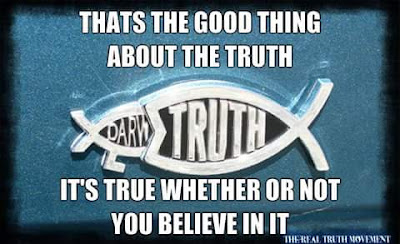From a human perspective, there is your truth and my truth and THE TRUTH. However, God is not human- He is so far above us that we can even completely understand HIM. And HIS TRUTH IS ABSOLUTE TRUTH BECAUSE HE IS ABSOLUTELY PURE. Man often will reject God's word as TRUTH because he rejects GOD. This Pilate did and many still do today. Please take a moment to consider the Scriptures I have listed below...
John, Chapter 18 (WEB)
33 Pilate therefore entered again into the Praetorium, called Jesus, and said to him, “Are you the King of the Jews?”
34 Jesus answered him, “Do you say this by yourself, or did others tell you about me?”
35 Pilate answered, “I’m not a Jew, am I? Your own nation and the chief priests delivered you to me. What have you done?”
36 Jesus answered, “My Kingdom is not of this world. If my Kingdom were of this world, then my servants would fight, that I wouldn’t be delivered to the Jews. But now my Kingdom is not from here.”
Jesus answered, “You say that I am a king. For this reason I have been born, and for this reason I have come into the world, that I should testify to the truth. Everyone who is of the truth listens to my voice.”
When he had said this, he went out again to the Jews, and said to them, “I find no basis for a charge against him.
John, Chapter 4 (WEB)
21 Jesus said to her, “Woman, believe me, the hour comes, when neither in this mountain, nor in Jerusalem, will you worship the Father. 22 You worship that which you don’t know. We worship that which we know; for salvation is from the Jews. 23 But the hour comes, and now is, when the true worshipers will worship the Father in spirit and truth, for the Father seeks such to be his worshipers. 24 God is spirit, and those who worship him must worship in spirit and truth.”
John, Chapter 8 (WEB)
42 Therefore Jesus said to them, “If God were your father, you would love me, for I came out and have come from God. For I haven’t come of myself, but he sent me. 43 Why don’t you understand my speech? Because you can’t hear my word. 44 You are of your father, the devil, and you want to do the desires of your father. He was a murderer from the beginning, and doesn’t stand in the truth, because there is no truth in him. When he speaks a lie, he speaks on his own; for he is a liar, and its father. 45 But because I tell the truth, you don’t believe me. 46 Which of you convicts me of sin? If I tell the truth, why do you not believe me? 47 He who is of God hears the words of God. For this cause you don’t hear, because you are not of God.”
Romans, Chapter 1 (WEB)
18 For the wrath of God is revealed from heaven against all ungodliness and unrighteousness of men, who suppress the truth in unrighteousness, 19 because that which is known of God is revealed in them, for God revealed it to them. 20 For the invisible things of him since the creation of the world are clearly seen, being perceived through the things that are made, even his everlasting power and divinity; that they may be without excuse. 21 Because, knowing God, they didn’t glorify him as God, neither gave thanks, but became vain in their reasoning, and their senseless heart was darkened.
Ephesians, Chapter 4 (WEB)
17 This I say therefore, and testify in the Lord, that you no longer walk as the rest of the Gentiles also walk, in the futility of their mind, 18 being darkened in their understanding, alienated from the life of God, because of the ignorance that is in them, because of the hardening of their hearts; 19 who having become callous gave themselves up to lust, to work all uncleanness with greediness. 20 But you did not learn Christ that way; 21 if indeed you heard him, and were taught in him, even as truth is in Jesus: 22 that you put away, as concerning your former way of life, the old man, that grows corrupt after the lusts of deceit; 23 and that you be renewed in the spirit of your mind, 24 and put on the new man, who in the likeness of God has been created in righteousness and holiness of truth.
Like so many people today, Pilate could not accept that there is an ABSOLUTE TRUTH and that TRUTH COMES FROM GOD ALONE. Why? There are probably almost countless reasons for disbelieving GOD'S TRUTH, but I think most of them revolve around the importance of SELF. If one's own opinion of SELF is put above the absolute of GOD, then those who do this become GOD in their own mind and therefore will not accept the absolutes of the ALMIGHTY. This is what the devil did and those that follow in his footsteps share his blinded heart (John 8, above).
Want to know truth? Listen to Jesus, because he was sent from the father to tell you THE TRUTH. Don't want to listen to Jesus? Do so at your own peril.
As always, these things apply to myself- so, listen to your own words, Gary!!!
And if they apply to me, then they apply to whoever reads this as well!!!


